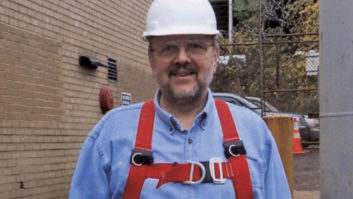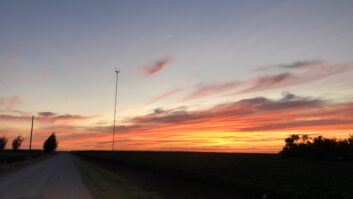Question: In a previous column you discussed the RF safety hazards associated with climbing a “hot” AM tower. I have a three-tower array that allows me to operate any one of the towers singularly in omnidirectional mode while personnel climb one of the other two towers. What are the RF safety concerns in doing this?
Climbing a de-energized tower in an AM array while another tower in the array is energized presents the same concerns as climbing an energized tower, albeit at somewhat lower levels.
The previous column (“Should I Climb That AM Tower?,” see radioworld.com under Columns/RF Safety) described the two major health concerns: RF shocks and burns (electrostimulation) that can occur when getting on or off the tower and induced currents that flow through the human body and are concentrated in the wrists and ankles when on the tower.
Induced currents are a result of the climber forming a branch circuit with the tower. Most of the current flows through the highly conductive steel, but some of it flows through the climber, and it is most concentrated where the cross-sectional diameter is the smallest: the climber’s wrists and ankles.
Any tower in a multi-tower array is going to make a very good receiving antenna for the operational tower unless you detune it. Therefore, it will pick up a great deal of RF energy. Getting on and off the tower presents the same type of RF burn hazard as a directly energized tower but does allow for a very useful work technique.
You can short the tower to ground when getting on or off to virtually eliminate the shock and burn hazard. This is the technique recommended by Tom Jones of Carl T. Jones Corp. Tom has a great deal of experience designing and working with AM transmission sites. He normally uses a heavy auto jumper cable to ground the tower.
With this technique, many people might be tempted to leave the short in place. But that is often not a wise decision.
There are so many variables — tower spacing, power level, antenna design — that it is difficult to give specific recommendations. But based on several computer models run by Tom and his engineers, it appears that the best technique generally is to remove the short and detune the tower. In fact, it is even better to detune the tower before you begin work and then simply short the tower when personnel are getting on or off the tower.
What about power levels?
Well, the recommendation for climbing energized towers is to limit the transmitter power level to an absolute maximum of 500 Watts to keep induced current levels in the wrists and ankles to an acceptable level. For non-energized towers in the same the same array, it is difficult to arrive at a level that I have total confidence in because of the many variables involved.
The best advice that I can give you, absent of specific modeling, is to detune the tower and to limit the transmitter power fed to the energized tower to a maximum of 5,000 Watts. When possible, use a tower at another location or get somebody competent like Tom Jones to run some models before you begin work.
Radio World offers a recurring series of Q&As with Richard Strickland of RF Safety Solutions, who has presented numerous public and private seminars on RF radiation safety and has written widely on the topic. The series is archived atradioworld.com.











